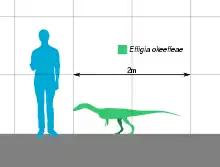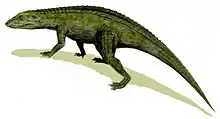Effigia
Effigia was an archosaur that lived in what is now New Mexico, south-western USA. It resembled the ornithomimid dinosaurs, although it was not a dinosaur.
| Effigia | |
|---|---|
 | |
| Effigia okeeffeae | |
| Scientific classification | |
| Kingdom: | Animalia |
| Phylum: | Chordata |
| Class: | Reptilia |
| Clade: | Suchia |
| Clade: | Paracrocodylomorpha |
| Branch: | †Poposauroidea |
| Family: | †Shuvosauridae |
| Genus: | †Effigia Nesbitt and Norell, 2006[1] |
| Species | |
| |
Discovery

The 2 metres (6 ft 7 in) fossil was collected by Edwin H. Colbert in blocks of rock from the Ghost Ranch Quarry, which were excavated in 1947 and 1948. However, Colbert did not think any large vertebrates besides basal theropod dinosaurs were present in the quarry and as such did not even open the jackets of most of the blocks that were returned to the American Museum of Natural History. The fossil was rediscovered in January 2006[2][3] by graduate student Sterling Nesbitt at the American Museum of Natural History. Nesbitt was opening jackets of blocks in order to find new specimens of Coelophysis. Upon finding the remains of Effigia, he instantly recognized this was not a dinosaur and proceeded to track down the rest of the blocks from that area of the quarry. Nesbitt and Mark Norell, curator at the museum, named it Effigia okeeffeae in January 2006 after Georgia O'Keeffe, who spent many years at Ghost Ranch.
Convergence
Effigia is noted for its remarkable similarity to ornithomimid dinosaurs. Nesbitt, in 2007, showed that Effigia was very similar to Shuvosaurus, and is definitely a member of the crurotarsan group Suchia (in the line leading towards modern crocodilians), and that its similarity to ornithomimids represents a case of "extreme" convergent evolution. Nesbitt also demonstrated that Shuvosaurus was the same animal as Chatterjeea, and that it belonged to an exclusive clade containing closely related suchians such as Shuvosaurus and Poposaurus (Poposauridae). Within this group, Effigia forms an even more exclusive clade with Shuvosaurus and the South American Sillosuchus (Shuvosaurinae).[4] In 2007, Lucas and others suggested "Effigia" was synonymous with "Shuvosaurus" and used the new combination "Shuvosaurus okeeffeae" for the animal.
References
- Nesbitt, Sterling J.; Norell, Mark A. (2006). "Extreme convergence in the body plans of an early suchian (Archosauria) and ornithomimid dinosaurs (Theropoda)". Proceedings of the Royal Society B: Biological Sciences. 273 (1590): 1045–1048. doi:10.1098/rspb.2005.3426. PMC 1560254. PMID 16600879.
- AMNH (October 2015). "Fossils of Ghost Ranch". America Museum of Natural History.
- "New Fossil Find in New Mexico Named After Artist Georgia O'Keeffe". Columbia University. February 2006.
- Nesbitt, S. (2007). "The anatomy of Effigia okeeffeae (Archosauria, Suchia), theropod-like convergence, and the distribution of related taxa." Bulletin of the American Museum of Natural History, 302: 84 pp. http://digitallibrary.amnh.org/dspace/handle/2246/5840
- Lucas, S.G., Spielmann, J.A., and Hunt, A.P., 2007, Taxonomy of Shuvosaurus, a Late Triassic archosaur from the Chinle Group, American Southwest: New Mexico Museum of Natural History and Science, Bulletin 41, p. 259-261.


